5 min to read
This article was originally published in January 2019, and was last updated in January 2020.
It seems like everyone and their mother has a blog these days. According to Neil Patel, there’s over a billion blogs on the internet. But that doesn’t mean that content marketing is a thing of the past.
In fact, content marketing is still very relevant in 2020. And with the online market becoming more saturated by the day, it’s more important than ever to stand out and create value for your potential customers.
Why Content Marketing?
Content is the fuel that drives the inbound marketing methodology.
Modern consumers don’t want to be sold to; they want to be empowered. Creating content that activates and engages the user at each stage of their customer journey makes this possible.
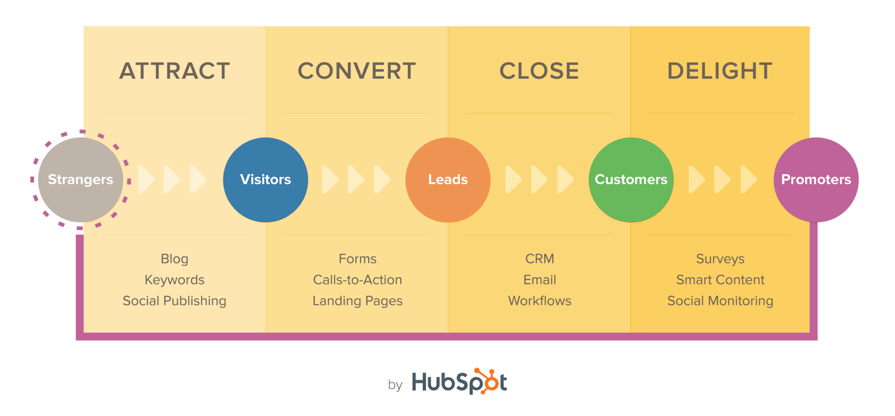
But the key to creating content that effectively works the conversion funnel is not quantity, but quality. And quality content doesn’t happen by coincidence- it takes strategic planning.
This is where your Content Calendar Template comes in.
How to Use the Content Calendar Template
If you haven’t already, start by Downloading the updated 2020 Content Calendar template.
Your template consists of 7 tabs:
• 2020 Calendar
• Content Plan Q1
• Content Plan Q2
• Content Plan Q3
• Content Plan Q4
• Content Repository
• Keyword Research
Each tab serves a key function in building an effective content strategy.
Your Content Strategy Starts with Keyword Research
Content is an integral part to Search Engine Optimization. And like all SEO techniques, the first step is Keyword Research.
Keyword research will help you understand the search behaviors of your target audience, and what is the best way to communicate with them.
Your keywords and content go hand in hand, so once you’ve identified your most valuable search terms, keep a copy of these on the Keyword Research tab of your Content Calendar.
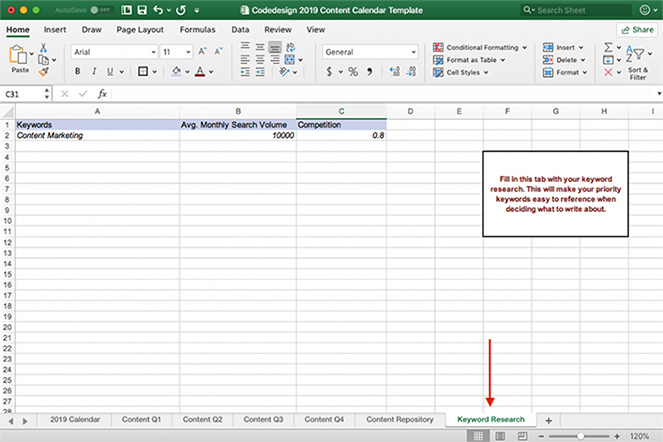
Read more on how to find the best keywords for your brand.
Deciding On Your Blog Topics
Brainstorming what to write about should be like every other step of your content strategy- strategic.
In order to facilitate the conversion funnel, each blog topic should correspond with a target keyword, target customer persona, and stage in the customer journey.
Your content should be designed to inspire and empower your potential customers, so you want to keep it as targeted as possible. If you’re unaware of who your target personas are, and what their typical customer journey looks like, you should go back to the drawing board before you start planning your content strategy.
You will want to plot these details out on the “Content” tabs of your Content Calendar. It’s best to plan your content topics for a pre-defined period of time in advance, whether that be a quarter or even one-month period. At the end of each period, you’ll want to reiterate all of the above processes.
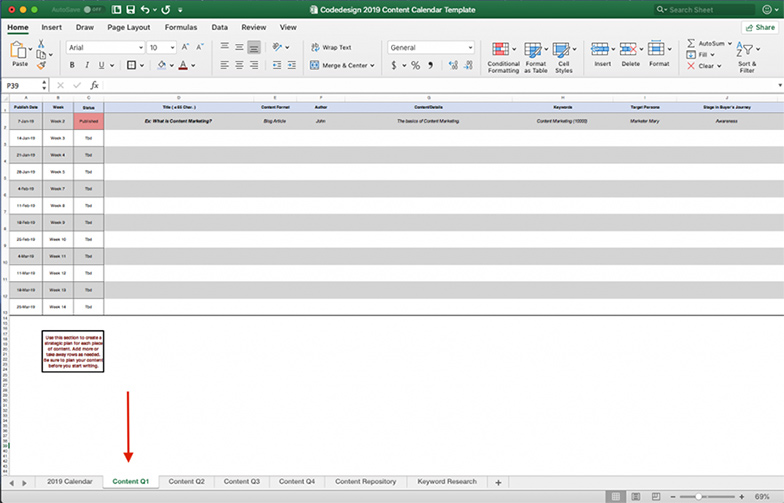
Creating that drives conversions means avoiding any “fluffy” blog topics and focusing on the subjects that are going to create value for your audience. Remember that the priority is quality, not quantity, so it’s better to have a few good blogs that serve a purpose than a myriad of watered-down content.
You can also add more rows to your content planning table. The more detailed your planning is, the easier your content will be to write and the closer you will be to hitting your content marketing goals.
Struggling to come up with fresh topics to write about? Check out these 5 resources to help generate content ideas.
Being Mindful of SEO Best Practices
Optimized meta descriptions and title tags are important for the organic visibility of your blog posts. One of the key elements of an optimized meta tag is that it is within Google's character limit.
The recently updated 2020 Content Calendar Template includes 4 new columns on the Content Tabs: Title Tag, Title Tag Length, Meta Description, Meta Description Length. These columns were intended to make it easier for you to follow SEO best practices.
Your Title Tag should be less than 60 characters. If it's too long, the Length Column will turn red. Remember, the Title Tag is different than the Article Title, so don't feel worried if you have to shrink it down a bit.
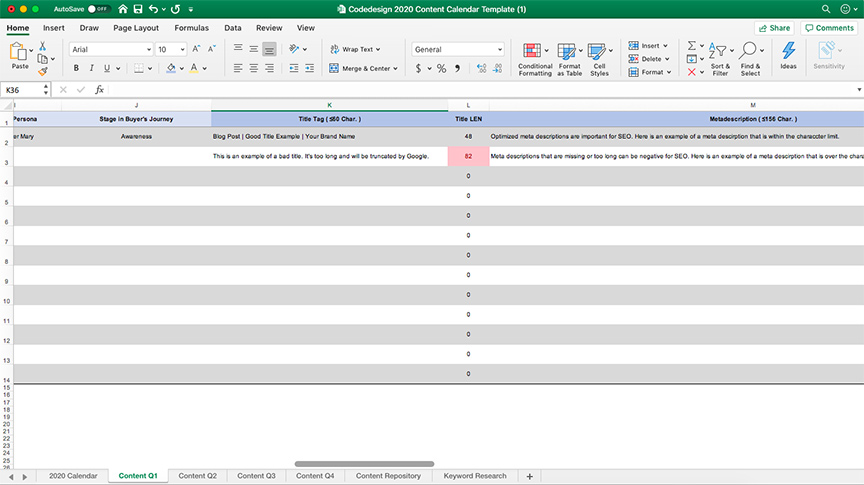
Your meta description should be less than 156 characters. Again, if it exceeds the character limit, the corresponding length column will turn red.
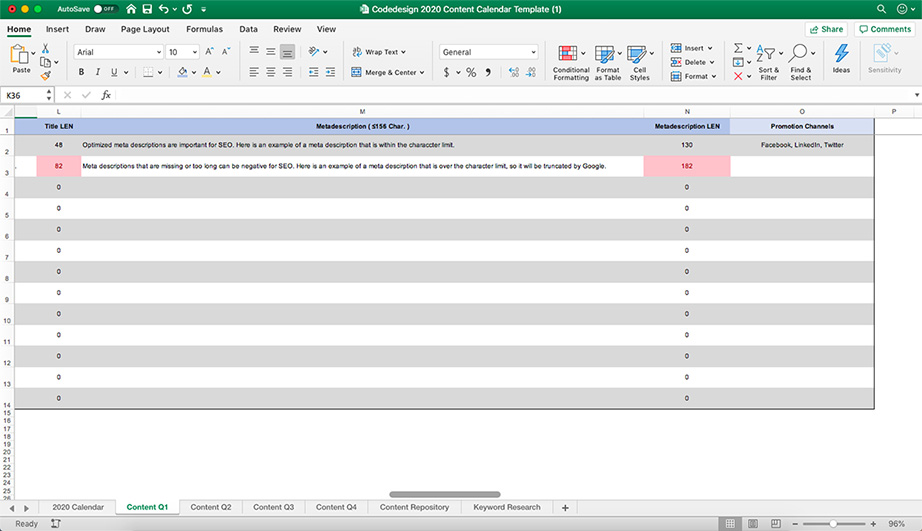
Note: keep in mind that Google is always changing the SERP features and character limits. To stay up to date on these changes, check in periodically with the SEO experts at Moz.
Scheduling Your Content
You want to make sure that your content calendar serves as a road map that keeps you on track for reaching your business objectives. This is done by keeping a clear and regular schedule in place.
Using the first tab, fill in the calendar with the publishing cycle that best suits your brand.
Depending on your industry, certain days of the week may be better to publish on than others. For example, if your website is focused on sharing fun things to do in the local area, you may want to publish closer towards the weekend. Conversely, if you have a marketing blog that is frequently visited by business professionals, you may want to opt for earlier in the week at the start of the working day.
Be sure to also include writing days, or days that the articles need to be submitted to approval to keep your entire team on track.
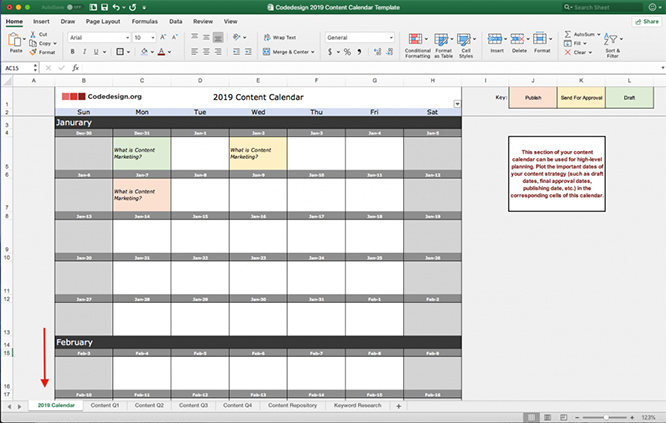
Keeping A Record of Your Content
As most content marketers know, the job isn’t done once an article is published. Content needs to be shared, promoted, recorded, and analyzed.
Maintaining a log of all your published content allows you to maintain organization amongst your team members, and squeeze the most benefit from your content.
As previously mentioned, content is a critical element at each stage of the conversion funnel. Having a list of content readily available means your sales or customer service team can easily share your articles with potential customers. By keeping your published content organized by theme, type, and size, you can know within a matter of seconds what is the best piece of content to empower a user and encourage their customer journey.
On the second to last tab, you’ll find your Content Repository. Fill this in retroactively with articles you’ve already published, and keep it up to date as you continue to produce content.
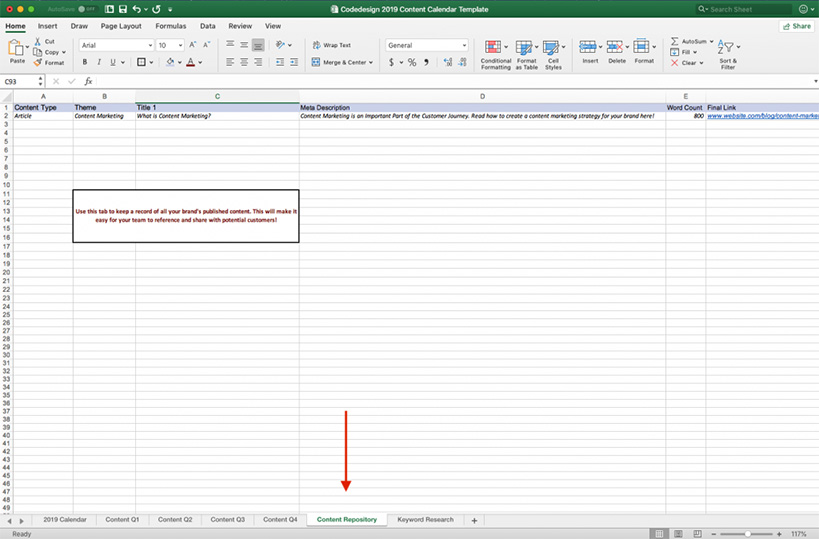
Iterating Your Content Strategy
Creating content that drives conversions is not as simple as crossing off items on a check list. It’s an ongoing, iterative process.
You need to be constantly reviewing your keywords, improving your targeting, and continuously shaping your content to better fit your customers needs.
Sometimes this does not mean producing new content, but by expanding and optimizing existing articles with tools like Google Search Console.
Remember, there’s over a billion blogs on the internet, so quality is more important than quantity. If you want to create a content strategy that not only stands out, but drives potential customers to convert, you need to start with a strategic plan.
Download the 2020 Content Calendar Template to Get Started
You could also check these local SEO services to boost your online presence.
Codedesign is a digital marketing agency specializing in data-driven online sales and lead generation solutions for brands in a variety of verticals. Contact us to schedule a consultation with one of our digital marketing experts.




Add comment ×